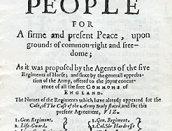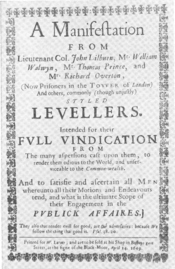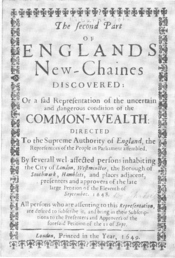In the mid-seventeenth century, two political factions erupted underneath the uneasiness and instability of a monarchy. One in England. The other in France. Both countries had long been embroiled in the Thirty YearsÃÂ War leaving both in financial turmoil and its subjects bitterly discontent. Seeking refuge from their ailing governments, these factions sought to implement edicts and other programs of government that would address their grievances and put them on the path of what they believed would be a more peaceful and financially successful existence.
Both radical in their times, the Levellers of England and the Ormée of Bordeaux, France shared a number of core beliefs that included popular sovereignty, the abolishment of part or all of parliament/parlement, and relief from taxes. To achieve these goals, both appealed to the masses. The Levellers issued numerous pamphlets and authored the weekly newspaper, The Moderate. Ormistes published mazarinades and participated in public demonstrations.
However, there were stark differences between the two. Whereas Levellers generally consisted of skilled workers, servants, and the dispossessed from various social levels, Ormeist were a class of one people, the bourgeois. They were shop owners, merchants, and artisans. The Levellers pursued a form of social leveling that would allow all groups of people to have a voice in their government. Ormistes pursued only their own classes interests and unlike the Levellers, were not opposed to extreme forms of violence not only with outsiders, but also with those in their own social class. Thispaper will attempt to further discuss these similarities and/or contrasting ideals and other points of interest.
It is necessary though, to point out first, one of the most significant differences between the Levellers and the Ormée. The Levellers ideals were meant to span entire borders. Their cause was more national and their primary goal was to change the entire constitution of England and deliver it to a commonwealth (Ludolph, Lecture 6). They sought to a establish a popular sovereign where all classes of people, from servants to nobles, were socially equal. This, they believed, was determined by God.
While the Ormée continually declared loyalty to their king, they believed that their bourgeois state provided them with a state of entitlement and the monarchy should be including them in policy making decisions rather than excluding them as a whole.
Unlike the Levellers, their political cause was limited to a province in France rather than the entire country itself (Ludolph, Lecture 14). Whether or not they were interested in becoming a national force is unknown. Though they were able to erect their form of government in Bordeaux, they were unable to reach beyond its borders.
Also, significantly different, were their platforms. Levellers, along with their political allies, demanded a number of individual rights. These included abolition of the monarch, House of Lords, and censorship. They sought free trade and speech and universal male suffrage and equality before the law (Seyssel, 58). They were able to gain popular support through publications that appealed to an individuals sense of right and wrong and urged Parliament to recognize the people whose backs the entire country rested upon.
These pamphlets included A Remonstrance of Many Thousand Citizens (1646),An Arrow Against All Tyrants (1646), EnglandÃÂs New Chains Discovered (1649), and Juries Justified (1651). In A Remonstrance of Many Thousand Citizens, Levellers argued that Parliament must be held accountable to the people.
We are your principals, and you our agents; it is a truth which you cannot but acknowledge. For if you or any other shall assume or exercise any power that is not derived from our trust and choice thereunto, that power is no less than usurpation and an oppression from which we expect to be freed, in whomsoever we find it ÃÂ it being altogether inconsistent with the nature of just freedom, which yealso very well understand (Roland).
ItÃÂs most significant publication however, was An Agreement of the People (1647). While the agreement was revised two times, its central premises included religious toleration, biennial Parliaments, and equality for all under the law.
That in all laws made or to be made every person may be bound alike, and that no tenure, estate, charter, degree, birth, or place do confer any exemption from the ordinary course of legal proceedings whereunto others are subjected. That as the laws ought to be equal, so they must be good, and not evidently destructive to the safety and well-being of the people (Seyssel, 58).
Although the Ormée were restricted to just a province in France, their ideas were grand. Ormeist were determined to abolish the entire Parlement and venality and replace them with elected persons of moral integrity. The majority of the people of Bordeaux were also being heavily taxed due to ongoing wars and the bourgeois wanted to alleviatethat burden and protect their established privileges within their own circle. Because the bourgeois believed that the financial instability in France was largely due to MazarinÃÂs 3personal misuse, the Ormée also demanded an accounting of the monies in Bordeaux.
This was highly unusual and radical as state finances were not privy to the general public.
The Ormée printed a number of mazarinades that lashed out against Mazarin, taxation, feudalism, intendants and parlement. ItÃÂs most significant was The Articles of the Union of the Ormée in the City of Bordeaux (1651).
We promise obedience to the King, service to our Governor, and fidelity to the good and advantage of our Country, for the Privileges and Franchises of which we will always be ready to risk our lives and goods: and in particular to support that in Bourgeois quality we have a deliberative voice and not only consultative in the general assemblies of City Hall, and to make accountable those who manages the last audiences (Seyssel, 203).
The use of these pamphlets in England and France were extremely influential. Levellers and Ormée were similarly able to reach a broader audience. An important difference between the English pamphlets and French mazarinades though, was that mazarinades were often more militaristic and provoked direct action. Leveller pamphlets reflected their ideals rather than consequences inflicted on Parliament if their demandswerenÃÂt met.
Up starting political parties rarely make it out of the dark shadows of dingy basements that they are first whispered in. Success usually relies on the coattails of who you know. The Leveller movement gained momentum when the New Model Army elected unofficial agitators called New Agents. This army had long been dissatisfied withthe Long Parliament. Soldiers had not received pay for months or been given exemption from punishment for their culpability in crimes committed while in service to the crown. Most importantly though, they felt that Parliament was becoming soft and negotiatingwith Charles without addressing any of their concerns (Ludolph, Lecture 6).
This provided opportunity for a successful Leveller infiltration. Together, they produced an AgitatorÃÂs manifesto, The Case of the Armies Truly Stated (1647) that proposed an addressing of soldier grievances, but also reflected some of the other issues that Levellers were associated with. Cromwell and Ireton desperately needed to retain the army and were willing to discuss government business with the Leveller movement in order to maintain it.
Like the Levellers, the Ormée were able to ally themselves with the incredibly influential and powerful princes. Though either side would willingly sacrifice the other in order to preserve their own causes, they did have something in common. Both equally disliked absolutism, wanted more influence in government, and felt Mazarin was the cause of FranceÃÂs heavy financial burden (Ludolph, Lecture 14). When Louis II de Bourbon, Prince de Condé became governor of Guyenne in 1651, the Ormée were able to establish a firm foothold in Bordeaux, his base of operation, and set themselves up to be the ruling majority.
Once the lines were clearly drawn and all the parties involved had chosen theirsides, other contrasting variances between the Levellers and Ormée presented themselves. Even at their most radical, the Levellers continued to follow the path of least resistance. They petitioned through the proper channels and peacefully, yet passionately, pleaded their case in several debates, including the Putney (1647) and Whitehall (1648) Debates. The Ormée, militaristic in nature, often resorted to mobs and extreme violence.
The next morning, 2,000 armed men from Saint Michel and Sainte Croix accompanied by women and children - atraditionally popular force demanding justice - marched on the hôtel de ville, where jurat du Bourdieu who was on duty collapsed and let them in. They took over the building, seized the arsenal and two or three cannons, rang the tocsin continuously, and spent several hours organizing a real fighting force as reinforcements streamed in. That afternoon the ormistes marched out behind their artillery and launched a two-pronged military attack on the Chapeau Rouge quarter (Doolin, 236).
They destroyed personal property, set government buildings on fire, and were willing to sacrifice lives.
The Leveller cause came to prominence in the 1640ÃÂs. It however, never achieved much political power. Cromwell and Ireton made some concessions, but by 1650, the movement lost its hold on popular government and a Leveller commonwealth never came to light.
The Ormée, however, were able to establish a ÃÂdemocraticàgovernment in Bordeaux. In 1652, they issued the Manifeste des Bordelois which demonstrated the power of the bourgeois in Bordeaux.
Those who would like to judge soundly the conduct of the Bourdelois since they joined with the domestic enemies ofFrance will find that they have not only given proof of asingular valor, but moreover they have this quality morestrongly than all other Frenchman, that they have stood up more zealously for the public good, have made greater effort to break the chains, and seem to have undertaken to give to all the Kingdom the liberty that we have lost for many Centuries (Seyssel, 201).
Ormée domination fell apart in mid 1653 due to its parochial limitations in Bordeaux and a rapid decline in public support. Order and the power of the regency were restored.
Most Leveller demands were unfulfilled, but a few including universal male suffrage, were added to a new constitution. Others would eventually reappear in later centuries. The Ormée never had a concise plan, but were still able to establish control and reform a problematic government. Having lasted only several years, the Leveller and Ormée movements were still able to leave a permanent stamp on history.
BIBLIOGRAPHYDoolin, Paul Rice. The Fronde. Cambridge, MA: Harvard University Press, 1935.
Ludolph, Patrick. ÃÂLecture 6: Wait, Who Killed the King.ÃÂ Lecture, UC-Santa Barbara, Santa Barbara, CA, August 12, 2008.
Ludolph, Patrick. ÃÂLecture 12.ÃÂ Lecture, UC-Santa Barbara, Santa Barbara, CA, August 21, 2008.ÃÂLudolph, Patrick. ÃÂLecture 14.ÃÂ Lecture, UC-Santa Barbara, Santa Barbara, CA, August26, 2008.
Roland, John. ÃÂSelected Works of the Levellers.ÃÂ 6 July 2005. 1 Sept. 2008.
http://www.constitution.org/lev/levellers.htmSeyssel, Clause. ÃÂThe Monarch of France.ÃÂ History 102LL. Edited by Patrick Ludolph, pgs. 58 - 203. Santa Barbara, CA: Alternative Copy Shop, 2008.



